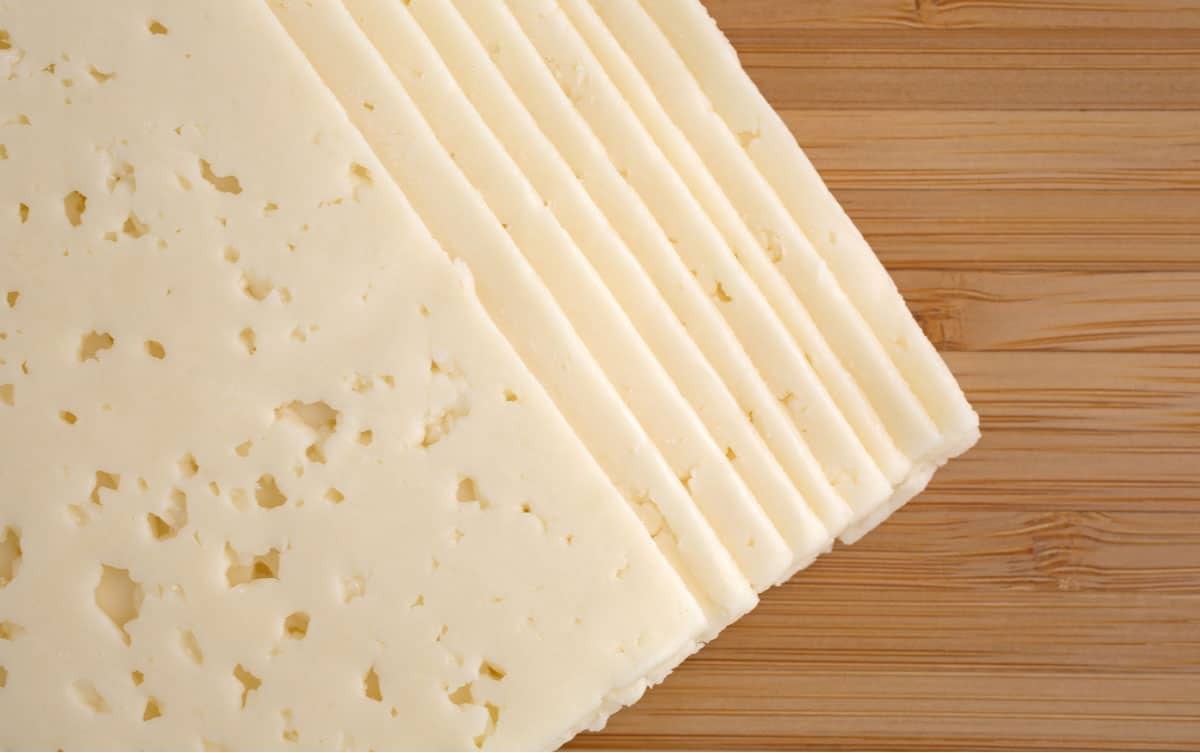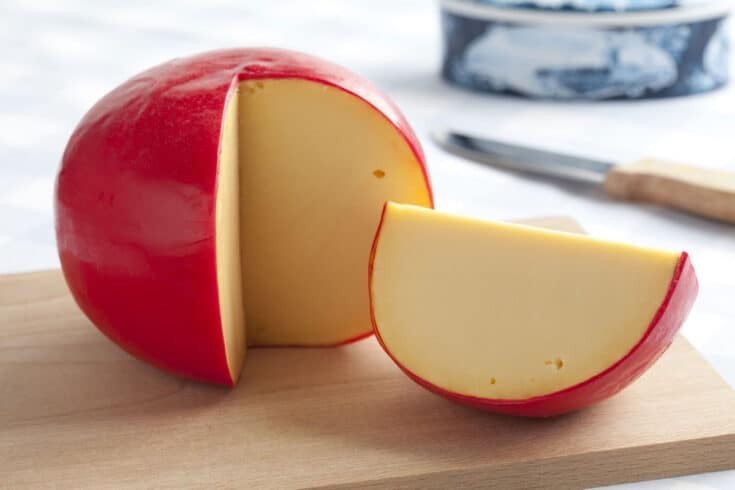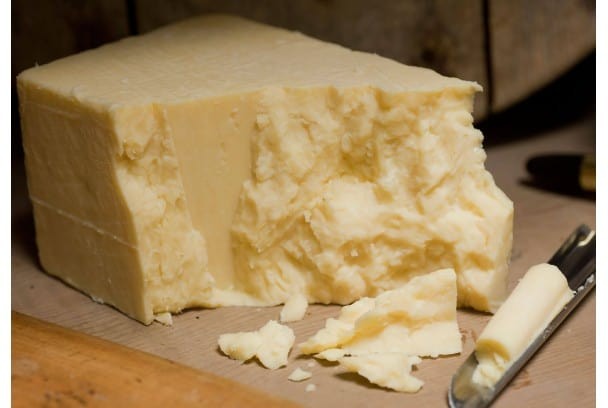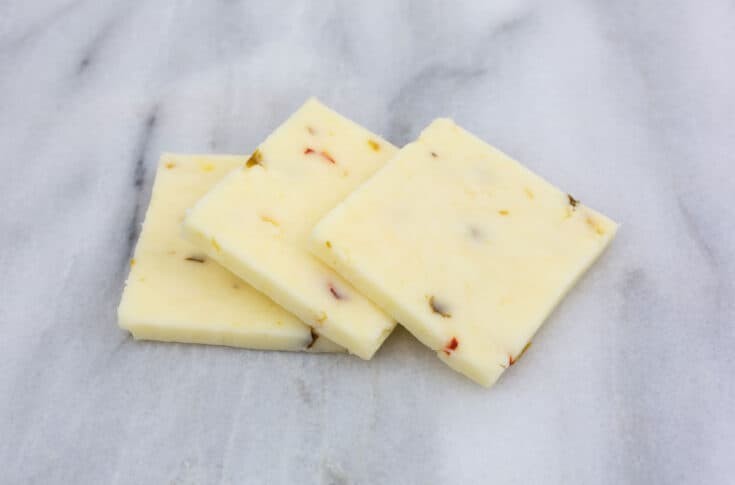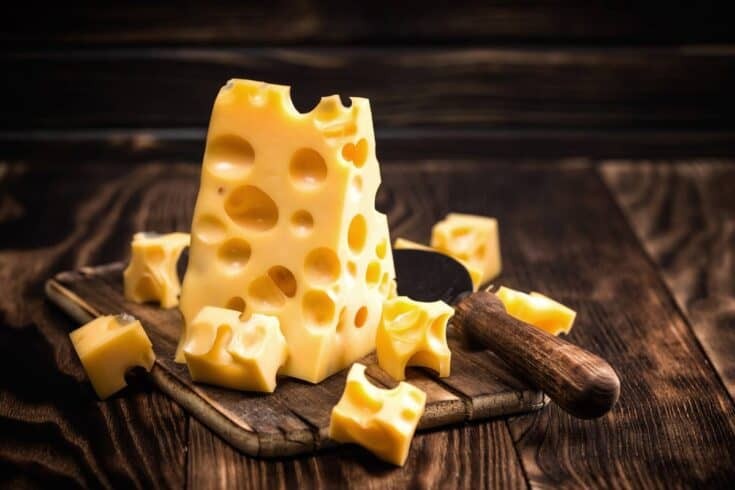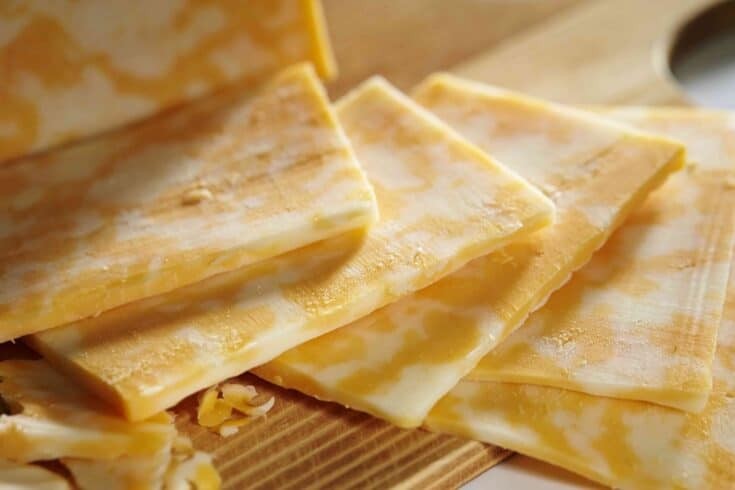Havarti cheese offers a distinct, buttery flavor that elevates many culinary creations, but finding a suitable stand-in is essential when it’s unavailable; COMPARE.EDU.VN delivers a comprehensive comparison, exploring various cheese types that share similar characteristics and can serve as excellent havarti alternatives. This guide dives deep into creamy cheese options, cheese flavor profiles, and cheese texture comparisons, ensuring you can maintain the integrity of your dish with a comparable substitute.
1. Understanding Havarti Cheese: A Profile
Havarti, a semi-soft cheese hailing from Denmark, is celebrated for its creamy, buttery flavor and smooth texture. Originating in the 1920s and once known as “Danish Tilsiter,” Havarti is made from cow’s milk and typically aged for around three months. This aging process develops its mild, slightly sweet taste, making it a versatile cheese appreciated by cheese connoisseurs and casual consumers alike. Havarti often features small, irregular openings, known as “eyes,” adding to its unique character and visual appeal.
1.1. Key Characteristics of Havarti
- Flavor Profile: Buttery, mild, and slightly sweet. Some varieties are infused with herbs like dill, caraway seeds, chives, or horseradish.
- Texture: Semi-soft, creamy, and smooth.
- Appearance: Cream-colored with small, irregular “eyes.”
- Melting Properties: Excellent melting capabilities, making it ideal for a wide range of dishes.
- Versatility: Suitable for cold sandwiches, grilled cheese, macaroni and cheese, and cheese boards.
Caption: Close-up of creamy havarti cheese slices, showcasing its texture and flavor, ideal for cheese lovers and culinary enthusiasts.
2. The Quest for Comparable Cheeses
When seeking a havarti cheese substitute, it’s essential to consider factors such as flavor, texture, melting properties, and intended use. Several cheeses share similarities with havarti and can be used as effective replacements in various recipes. Let’s explore some of the best options, providing detailed cheese descriptions to help you make the right choice.
2.1. Tilsit Cheese
Tilsit cheese, a semi-hard cheese originating from Europe, is an excellent substitute for havarti due to its similar flavor profile. Both cheeses feature small holes and a pale yellow color. Tilsit melts well and has a texture comparable to havarti. Often flavored with caraway seeds or peppercorns, Tilsit can be added to salads, melted into casseroles, or used in fondue.
- Flavor: Similar to havarti, with a slightly tangy note.
- Texture: Semi-hard, smooth, and creamy.
- Melting: Melts well, making it suitable for cooked dishes.
- Usage: Salads, casseroles, fondue, and cheese boards.
2.2. Edam Cheese
Edam cheese, a Dutch cheese made from cow’s milk, is another excellent havarti alternative. It offers a sweet, buttery flavor that closely resembles havarti. While Edam is a semi-hard cheese, selecting a younger version can minimize differences in texture. Young Edam pairs well with fruits like peaches and cherries, while aged Edam can be used in salads with apples or pears.
- Flavor: Sweet and buttery, similar to havarti.
- Texture: Semi-hard, but younger versions are softer.
- Melting: Melts well, suitable for cooking.
- Usage: Cheese boards with fruit, salads, and sandwiches.
Caption: Edam cheese block with a slice, emphasizing its texture and creamy profile, perfect for comparing with other cheese varieties.
2.3. Saint Paulin Cheese
Saint Paulin is a French cheese known for its creamy, mild flavor and semi-soft texture. Originally crafted by Trappist monks, this cow’s milk cheese is firm enough for slicing on sandwiches yet soft enough to be grated into cheese sauces. Its washed-rind, colored with annatto, enhances its flavor profile. Saint Paulin is often served as a dessert cheese, pairing well with light-bodied red or white wines and fresh fruit.
- Flavor: Creamy and mild.
- Texture: Semi-soft, smooth, and sliceable.
- Melting: Melts well, suitable for sauces and gratins.
- Usage: Sandwiches, cheese sauces, dessert cheese with wine and fruit.
2.4. Mild Cheddar Cheese
Mild cheddar cheese, especially young cheddar, can serve as a worthy substitute for havarti. Made from cow’s milk, young cheddar is the most popular cheese in the UK. Mild cheddar offers a subtle flavor and smooth texture, making it ideal for melting in dishes where you would typically use havarti. It’s delicious in baked cheddar biscuits, burgers, and on cheese boards with crackers and apples.
- Flavor: Mild and slightly tangy.
- Texture: Semi-hard, smooth, and creamy.
- Melting: Melts well, especially young cheddar.
- Usage: Baked biscuits, burgers, cheese boards, and sandwiches.
Caption: Close-up of a cheddar cheese block, illustrating its texture and potential as a versatile melting cheese substitute.
2.5. Monterey Jack Cheese
Monterey Jack cheese, often called “Jack,” is a California cheese made from cow’s milk with a mild flavor similar to havarti. Aged for about six months, Monterey Jack has a slightly stronger flavor than havarti. Its excellent melting properties make it a great choice for grilled cheese, quesadillas, and bean and cheese burritos. It’s often combined with Colby cheese to create Colby Jack, known for its marbled appearance and delicious flavor.
- Flavor: Mild and slightly stronger than havarti.
- Texture: Semi-hard, smooth, and creamy.
- Melting: Melts very well, ideal for cooked dishes.
- Usage: Grilled cheese, quesadillas, burritos, and sandwiches.
2.6. Young Gouda Cheese
Young gouda cheese has a mild flavor that makes it an excellent replacement for havarti. Gouda, a Dutch cheese, is one of the oldest recorded cheeses still produced today. Unlike aged gouda, which has a sharper, caramel-like flavor, young gouda is mild-tasting with a semi-soft texture. Its wax rind must be removed before consumption. Young gouda is a great addition to quiches and breakfast frittatas.
- Flavor: Mild and slightly nutty.
- Texture: Semi-soft and smooth.
- Melting: Melts well, suitable for cooking.
- Usage: Quiches, frittatas, sandwiches, and cheese boards.
Caption: Fresh Monterey Jack cheese, perfect for highlighting its mild flavor and melting qualities, showcasing it as a havarti replacement.
2.7. Emmental Cheese
Emmental cheese, a Swiss or alpine-style cheese from Switzerland, is known for its distinctive holes. Often referred to as “Swiss cheese,” Emmental has a slightly nutty and fruity flavor, making it a worthy substitute for havarti. Made from cow’s milk, this cheese has an inedible rind and a semi-firm texture. It’s commonly melted into fondue or used in sauces, over potatoes, or in cold sandwiches.
- Flavor: Nutty and fruity.
- Texture: Semi-firm and creamy.
- Melting: Melts well, ideal for fondue and sauces.
- Usage: Fondue, sauces, gratins, sandwiches.
2.8. Colby Cheese
Colby cheese, a semi-hard cheese from Wisconsin, is another excellent substitute for havarti. It’s one of Wisconsin’s most famous cheeses, known for its subtle flavor and smooth texture. Colby is often combined with Monterey Jack to make Colby Jack, appreciated for its marbled appearance and mild flavor. Colby melts well and can be used in both cooked and cold dishes. Try it sliced on a sandwich or melted in your favorite recipes.
- Flavor: Subtle and mild.
- Texture: Semi-hard and smooth.
- Melting: Melts well, ideal for cooking and melting.
- Usage: Sandwiches, grilled cheese, quesadillas, and snacks.
Caption: An Emmental cheese block, ideal for illustrating its texture and Swiss origins, suitable for cheese comparison articles.
2.9. Esrom Cheese
Esrom cheese, also known as Danish Port Salut, is a semi-soft cheese made from cow’s milk with a slightly pungent flavor. Like havarti, Esrom has small holes and a buttery texture. Its bold flavor pairs well with dark beers and red wines. In Denmark, Esrom is commonly used in open-faced sandwiches with smoked fish, radishes, and onions.
- Flavor: Slightly pungent and buttery.
- Texture: Semi-soft and smooth.
- Melting: Melts well, suitable for cooking.
- Usage: Open-faced sandwiches, cheese boards, and snacks.
3. A Detailed Comparison Table
To provide a clearer understanding of how these cheeses compare to havarti, here’s a detailed comparison table:
| Cheese | Origin | Flavor | Texture | Melting Properties | Common Uses |
|---|---|---|---|---|---|
| Havarti | Denmark | Buttery, mild, sweet | Semi-soft | Excellent | Sandwiches, grilled cheese, macaroni and cheese, cheese boards |
| Tilsit | Europe | Similar to havarti | Semi-hard | Good | Salads, casseroles, fondue |
| Edam | Netherlands | Sweet, buttery | Semi-hard | Good | Cheese boards with fruit, salads |
| Saint Paulin | France | Creamy, mild | Semi-soft | Good | Sandwiches, cheese sauces, dessert cheese |
| Mild Cheddar | UK | Mild, slightly tangy | Semi-hard | Good | Baked biscuits, burgers, cheese boards |
| Monterey Jack | USA | Mild, slightly strong | Semi-hard | Excellent | Grilled cheese, quesadillas, burritos |
| Young Gouda | Netherlands | Mild, slightly nutty | Semi-soft | Good | Quiches, frittatas, sandwiches |
| Emmental | Switzerland | Nutty, fruity | Semi-firm | Good | Fondue, sauces, gratins |
| Colby | USA | Subtle, mild | Semi-hard | Excellent | Sandwiches, grilled cheese, snacks |
| Esrom | Denmark | Slightly pungent | Semi-soft | Good | Open-faced sandwiches, cheese boards |
This table provides a quick reference for selecting the best havarti substitute based on your specific needs.
4. Factors to Consider When Choosing a Substitute
Selecting the right havarti substitute depends on various factors. Here are some key considerations to help you make the best choice:
4.1. Flavor Profile
Consider the flavor profile of the substitute in relation to the dish. For instance, if you need a mild, buttery flavor, Edam or young Gouda are excellent choices. If you desire a slightly tangy flavor, Tilsit or mild Cheddar might be preferable.
4.2. Texture
The texture of the cheese is another important factor. If you need a semi-soft, creamy texture, Saint Paulin or Esrom are good options. For semi-hard textures, consider Monterey Jack or Colby.
4.3. Melting Properties
If the cheese is intended for melting, choose substitutes known for their excellent melting properties. Monterey Jack, mild Cheddar, and Emmental are all great choices for cooked dishes.
4.4. Intended Use
Consider the specific recipe or application. For cheese boards, Edam or Saint Paulin pair well with fruits. For sandwiches, mild Cheddar or Monterey Jack are versatile options. For sauces and gratins, Emmental or Saint Paulin can add depth and richness.
Caption: Cheese blocks with papaya chutney, perfect for cheese selection guides.
5. Recipes and Applications
Here are some recipes and applications where these havarti substitutes can shine:
5.1. Grilled Cheese Sandwich
- Havarti: Provides a buttery, smooth, and delicious melt.
- Monterey Jack: Offers a similar mild flavor and excellent melting capabilities.
- Mild Cheddar: Adds a slightly tangy twist while still melting beautifully.
5.2. Macaroni and Cheese
- Havarti: Creates a creamy, rich, and decadent sauce.
- Saint Paulin: Offers a similar creamy texture and mild flavor.
- Emmental: Adds a nutty and slightly fruity dimension to the dish.
5.3. Cheese Board
- Havarti: A versatile choice that pairs well with many accompaniments.
- Edam: Complements richer fruits like peaches and cherries.
- Young Gouda: Offers a mild, slightly nutty flavor that pairs well with crackers and nuts.
5.4. Open-Faced Sandwiches
- Havarti: Provides a mild and buttery base.
- Esrom: Adds a slightly pungent flavor that pairs well with smoked fish and vegetables.
5.5. Cheese Sauces
- Havarti: Creates a smooth, creamy, and rich sauce.
- Saint Paulin: Offers a similar creamy texture and mild flavor.
- Emmental: Adds a nutty and slightly fruity dimension to the sauce.
6. Exploring Regional Cheese Varieties
Different regions offer unique cheese varieties that can serve as havarti substitutes. Here are some regional cheese options to consider:
6.1. Dutch Cheeses
The Netherlands is renowned for its cheese production, offering excellent havarti alternatives like Edam and Gouda. These cheeses are widely available and offer distinct flavor profiles that can enhance your culinary creations.
6.2. Swiss Cheeses
Switzerland is famous for its alpine-style cheeses, including Emmental. These cheeses are known for their nutty and fruity flavors and excellent melting properties, making them suitable for fondue and gratins.
6.3. French Cheeses
France offers a variety of creamy, semi-soft cheeses, such as Saint Paulin, that can serve as havarti substitutes. These cheeses are known for their smooth texture and mild flavor, making them ideal for sandwiches and cheese sauces.
6.4. American Cheeses
The United States produces a wide range of cheeses, including Monterey Jack and Colby. These cheeses are versatile and offer excellent melting properties, making them suitable for various cooked dishes.
Caption: Close-up of a block of Colby cheese and slice, showcasing its texture and potential as a melting cheese substitute.
7. The Nutritional Aspects
When substituting cheeses, it’s also important to consider their nutritional profiles. Here’s a general comparison:
| Cheese | Calories (per oz) | Fat (g) | Protein (g) | Calcium (mg) |
|---|---|---|---|---|
| Havarti | 120 | 10 | 7 | 200 |
| Tilsit | 100 | 8 | 7 | 180 |
| Edam | 99 | 7.8 | 25 | 731 |
| Saint Paulin | 100 | 8 | 7 | 150 |
| Mild Cheddar | 115 | 9 | 7 | 204 |
| Monterey Jack | 106 | 8.5 | 6.9 | 204 |
| Young Gouda | 119 | 10 | 7 | 200 |
| Emmental | 111 | 8 | 8 | 260 |
| Colby | 112 | 9 | 7 | 186 |
| Esrom | 110 | 9 | 7 | 150 |
These values are approximate and can vary based on brand and specific cheese variety. Always check the nutritional information on the product label for accurate details.
8. Pairing Suggestions
Pairing cheese with complementary flavors can enhance your culinary experience. Here are some pairing suggestions for havarti and its substitutes:
8.1. Havarti
- Fruits: Apples, pears, grapes
- Nuts: Walnuts, almonds
- Wine: Light-bodied white wines like Riesling or Pinot Grigio
8.2. Tilsit
- Beer: Dark beer or brown ale
- Accompaniments: Caraway seeds, peppercorns
- Fruits: Apples, pears
8.3. Edam
- Fruits: Peaches, cherries
- Wine: Light-bodied red wines like Beaujolais
- Accompaniments: Crackers, bread
8.4. Saint Paulin
- Fruits: Grapes, figs
- Wine: Light-bodied red or white wines
- Accompaniments: Crackers, bread
8.5. Mild Cheddar
- Fruits: Apples, pears
- Beer: Pale ale
- Accompaniments: Crackers, bread
8.6. Monterey Jack
- Accompaniments: Jalapeños, salsa
- Beverages: Beer, iced tea
- Dishes: Quesadillas, burritos
8.7. Young Gouda
- Fruits: Apples, pears
- Wine: Light-bodied white wines
- Accompaniments: Crackers, nuts
8.8. Emmental
- Wine: Dry white wines like Sauvignon Blanc
- Accompaniments: Bread, olives
- Dishes: Fondue, gratins
8.9. Colby
- Accompaniments: Crackers, deli meat
- Beverages: Milk, iced tea
- Dishes: Sandwiches, snacks
8.10. Esrom
- Beer: Dark beer
- Wine: Bold red wines
- Accompaniments: Smoked fish, radishes, onions
9. Expert Tips for Cheese Selection
Here are some expert tips to help you select the best cheese for your needs:
9.1. Read the Label
Always read the label to understand the ingredients, nutritional information, and aging process.
9.2. Check the Texture
Examine the texture of the cheese to ensure it aligns with your desired consistency.
9.3. Smell the Cheese
Smell the cheese to get an indication of its flavor profile. Fresh cheeses should have a clean, mild aroma, while aged cheeses may have more complex scents.
9.4. Ask for a Sample
If possible, ask for a sample to taste the cheese before purchasing.
9.5. Buy from Reputable Sources
Purchase cheese from reputable sources that prioritize quality and freshness.
10. Frequently Asked Questions (FAQs)
1. What makes havarti cheese unique?
Havarti is unique due to its buttery, mild flavor, creamy texture, and excellent melting properties. It also features small, irregular openings known as “eyes.”
2. Can I use any cheese as a substitute for havarti?
While many cheeses can be used as substitutes, the best options share similar flavor and texture profiles. Consider cheeses like Tilsit, Edam, or mild Cheddar.
3. Which cheese melts best as a havarti substitute?
Monterey Jack, mild Cheddar, and Emmental are excellent melting cheeses that can be used in place of havarti.
4. How does the aging process affect cheese flavor?
The aging process significantly impacts cheese flavor. Younger cheeses tend to have milder, more delicate flavors, while aged cheeses develop more complex, robust profiles.
5. Are there flavored varieties of havarti?
Yes, havarti is often flavored with herbs like dill, caraway seeds, chives, or horseradish.
6. Is havarti a good cheese for people with lactose intolerance?
Havarti is relatively low in lactose compared to some other cheeses. People with mild lactose intolerance may be able to tolerate it in small quantities.
7. How should havarti cheese be stored?
Havarti cheese should be stored in the warmest part of your fridge, such as the vegetable or cheese drawer, wrapped in cheese paper or plastic wrap.
8. What are some popular dishes that use havarti cheese?
Popular dishes that use havarti cheese include grilled cheese sandwiches, macaroni and cheese, cheese boards, and cold sandwiches.
9. Can I freeze havarti cheese?
Freezing havarti cheese is not recommended, as it can alter the texture and flavor.
10. What wines pair well with havarti cheese?
Light-bodied white wines like Riesling or Pinot Grigio pair well with havarti cheese.
At COMPARE.EDU.VN, we understand the importance of making informed decisions. Finding the perfect havarti substitute can be a breeze with the right information. Whether you’re seeking a cheese for melting, slicing, or adding to a cheese board, our comprehensive comparisons and expert tips can guide you to the best choice.
Ready to explore more cheese comparisons and discover the perfect substitute for your next culinary adventure? Visit compare.edu.vn today and make informed decisions with confidence. Contact us at 333 Comparison Plaza, Choice City, CA 90210, United States or via Whatsapp at +1 (626) 555-9090.
